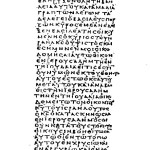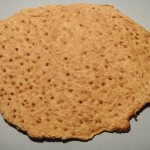Korach does not get a great deal of good press. Typical are these comparisons to, well Goebbels, and here is another linking him with the Tea Party. Also Avodah has a piece on Korach the Populist Demagogue. (Updated 6/28/2015 – also Robert E. Lee).The point of contact between Korach and these terrible people and institutions is the commentary on Psalm 1 found in Midrash Shocher Tov. The Psalmist begins with the negative attributes of the happy and prosperous: Happy is the man who does not walk with the counsel of the wicked, stand in the path of sinners, or dwell in the company of scorners. It is on the company of scorners that the midrash takes up Korach (translation mine with scriptural citations in bold):
“ובמושב לצים…” זה קרח, שהיה מתלוצץ על משה ועל אהרן
מה עשה קרח? כינס כל הקהל, שנאמר “ויקהל עליהם קרח את כל העדה”, והתחיל לומר להם דברי ליצנות, ואומר להם: אלמנה אחת היתה בשכונתי והיו עמה שתי נערות יתומות, והיתה לה שדה אחת. באה לחרוש – אמר לה משה (דברים כ”ב): “לא תחרוש בשור וחמור יחדו.” באה לזרוע – אמר לה (ויקרא י”ט י”ט): “שדך לא תזרע כלאים.” באה לקצור ולעשות ערמה, אמר לה: הניחי לקט שכחה ופאה. באה לעשות קרן, אמר לה: תני תרומה ומעשר ראשון ומעשר שני. הצדיקה עליה את הדין ונתנה לו.
מה עשתה עניה זו? עמדה ומכרה את השדה וקנתה שתי כבשות כדי ללבוש מגזותיהן ולהנות מפרותיהן. כיון שילדו – בא אהרן ואמר לה: תני לי את הבכורות, שכך אמר לי הקב”ה (דברים ט”ו י”ט): “כל הבכור אשר יולד בבקרך ובצאנך הזכר – תקדיש לה’ אלוהיך.” הצדיקה עליה את הדין ונתנה לו את הולדות. הגיע זמן גזיזה וגזזה אותן – בא אהרן ואמר לה: תני לי ראשית הגז שכך אמר הקב”ה (דברים י”ח ד’): “ראשית דגנך תירושך ויצהרך וראשית גז צאנך תתן לו.” (לכהן).
אמרה: אין בי כח לעמוד באיש הזה, הרי אני שוחטת אותן ואוכלתן. כיון ששחטה אותן בא אהרן ואמר לה: תני לי הזרוע והלחיים והקיבה. אמרה: אפילו אחרי ששחטתי אותן, לא נצלתי מידו – הרי הן עלי חרם! אמר לה אהרן: אם כן – כולה שלי הוא, שכך אמר הקב”ה (במדבר י”ח י”ד): “כל חרם בישראל לך יהיה.” נטלן והלך לו והניחה בוכה היא עם שתי בנותיה.
כך עלתה לעלובה זו! כל כך הם עושים ותולים בקב”ה!
And in the place of scorners – This is Korach, who mocked Moshe and Aaron.
What did he do? He gathered the assembly for it says he assembled against them the entire assembly. And he commenced to pronounce words of scorn. He told them as follows:
There was a widow with two orphaned daughters and she had a field. She set out to plow and Moshe said to her Do not plow with an ox and a donkey together (presumably her only two animals), she set out to plant and Moshe said Don’t plant a mixture of seeds in your field. When it was time to harvest he said Leave the gleanings and the corners of your field for the poor. When she wanted to set aside a surplus he said, “Pay me the priestly taxes, the levitical tithe and the tithe for the poor.” She acted in accordance with the law and paid him.
What did this poor woman do? She sold the field and bought two sheep to use the wool for clothing and to sell their offspring. When they gave birth, Aaron came and said “Give me the firstborn” as it is written Each male firstborn from the herd or from the flock shall be dedicated to God. She acted in accordance with the law and gave him the offspring. The time for shearing came and Aaron said, “Give me the first shearing” as it is written The first of your grain, wine and oil, and the first shearing you shall give to the priest. The woman said, “I do not have the strength to abide this man. I will kill my sheep and eat them.” Aaron said, “Give me the shoulder, the jaw and the gullet.” She said, “Even if I kill them I can’t keep them out of his hand. I declare a herem upon them!” Aaron said, “If so, then it all belongs to me,” as it is written All of the herem will be for you. He took them and and left, leaving her weeping with her two daughters. Thus she came to this wretched state of affairs. This are the things that Moshe and Aaron do and ascribe to God.
The defense of Moshe and Aaron take a few standard forms: Because they haven’t even come into the land to institute all of these laws yet Korach is clearly lying, the fact that the widow would rather place her sheep in herem before she shares them with the poor demonstrates that she is greedy, etc. The Daily Kos accuses Korach of being a pioneer in using “wedge issues” to alienate the poor from their true interests:
But Korach was inciting the poor to follow him in destroying an incipient taxing and welfare system that was designed to keep the poor fed, clothed and housed – a taxing and welfare system that would greatly expand by the end of the Second Temple period in 70 CE.
In his commentary on the Torah Em LaMikra, R. Eliyahu Benamozegh makes the following observation at the beginning of Parasha Korach: He cites in full the midrash from Shocher Tov, and states that, “Every literate person who reads this midrash thinks immediately of the heretic Voltaire.” Not only that, Benamozegh continues, this midrash can be found in a nearly complete form under the heading _Curate_ in Voltaire’s Philosophical Dictionary. The below is taken from The Works of Voltaire, A Contemporary Version, (New York: E.R. DuMont, 1901), A Critique and Biography by John Morley, notes by Tobias Smollett, trans. William F. Fleming.
Believe not, dear reader, that the Jews, who were a stiff-necked people, never complained of the extortion of the tenths, or tithe. Give yourself the trouble to consult the Talmud of Babylon, and if you understand not the Chaldæan, read the translation, with notes of Gilbert Gaumin, the whole of which was printed by the care of Fabricius. You will there peruse the adventure of a poor widow with the High Priest Aaron, and learn how the quarrel of this widow became the cause of the quarrel of Koran, Dathan, and Abiram, on the one side, and Aaron on the other.
“A widow possessed only a single sheep which she wished to shear. Aaron came and took the wool for himself: ‘It belongs to me,’ said he, ‘according to the law, thou shalt give the first of the wool to God.’ The widow, in tears, implored the protection of Koran. Koran applied to Aaron but his entreaties were fruitless. Aaron replies that the wool belongs to him. Koran gives some money to the widow and retires, filled with indignation.
“Some time after, the sheep produces a lamb. Aaron returns and carries away the lamb. The widow runs weeping again to Koran, who in vain implores Aaron. The high priest answers, ‘It is written in the law, every first-born male in thy flock belongs to God.’ He eats the lamb and Koran again retires in a rage.
“The widow, in despair, kills her sheep; Aaron returns once more and takes away the shoulder and the breast. Koran again complains. Aaron replies: ‘It is written, thou shalt give unto the priests the shoulder, the two cheeks, and the maw.’
“The widow could no longer contain her affliction and said, ‘Anathema,’ to the sheep, upon which Aaron observed, ‘It is written, all that is anathema (cursed) in Israel belongs to thee;’ and took away the sheep altogether.”
What is not so pleasant, yet very remarkable, is that in a suit between the clergy of Rheims and the citizens, this instance from the Talmud was cited by the advocate of the citizens. Gaumin asserts that he witnessed it. In the meantime it may be answered that the tithe-holders do not take all from the people, the tax-gatherers will not suffer it. To every one his share is just.
Benamozegh goes on the explore the late literary path of this midrash and how it ended up in front of Voltaire. I’m unsure of his purpose of bringing this forward in Em LaMikra (besides that it’s pretty cool), but the comparison with Korach and Voltaire underlines the uneasy relationship between Judaism and the Enlightenment. It can be hard for one who wants, like me, to live in both worlds. Yes, Voltaire is a heretic and anti-semitic, but he is also Voltaire. I find it impossible to imagine living without not just his literature, but his attitudes against abusive authority are a precious legacy for all who live in the West and all citizens of the United States. Jefferson, among many of the founders, was a big fan of Voltaire. The “demagogue” of Midrash Shocher Tov seems very American to me.
I also wonder how innocently Judaism requires us to read Scripture. On the Arachim website we read:
Korach incorporated other elements of modern-day propaganda as well. His one-sided story entirely ignored the important roles the priests and Levites played for the entire nation, and the fact that most of them were poor, spending their time teaching the nation G-d’s Torah and serving in the Temple for the spiritual sake of the people. The widow’s story failed to mention the Heavenly blessing pouring down on those who set aside a portion of their resources for tzedaka (charity) such as tithes to the priests and the poor, not to mention the absurd exaggeration Korach worked in, hinting that the amount that each person had to give made the priests wealthy off the backs of the poor. What a joke! The priests were the poor.
Well, maybe, but I can’t read that without my brain screaming, “Who’s being naive, Kay?” Should we read the Torah with the understanding that everything is going to implemented according to the elevated good intentions of those with power, or with the perspective that political institutions will wield power the same way it has been everyplace and everytime else? And there are non-innocent ways to read the text that are quite disturbing. Today we think of Levi’im as the second of three classes (they get the second aliyah after all). And from this point of view Korach is just being greedy. However, there are clues in the Torah to the contrary; that the Levi’im were the Hierodules – the slaves to the priestly caste whose actual social status was lower than everyone else (which is why Deuteronomy always throws them in with the other outcasts – widows, strangers and orphans). It is possible to read לעבוד עבודה באוהל מועד in a very negative register (i.e. to perform servile labor in the Tent of Meeting), and when one does so the impression of Korach is quite different (and his denouement becomes quite chilling.)
The comparison of Korach and Voltaire also raises the inadequacy of the usual rabbinic slogan that we should make our disputes for the “sake of heaven”, like Shammai and Hillel and not in the manner of Korach. In many cases that is good advice and I always try to remember that the guy who wants to light his Hanukkah candles in the opposite manner that I do has his own point of view that is worthy of respect. But do we really want that for things we actually care about? Should our argument about slavery be like the disputes between Hillel and Shammai? About racism? Is our debate over whether women should be allowed to drive and walk around with their heads uncovered a debate for the sake of heaven? Or are they debates for the sake of slaves and for the sake of women? Robert Conquest has pointed out that everyone is reactionary about the things they feel are truly important and it seems to me that is as it should be. In the course of human events, sometimes you need a little Korach.

 Every year when we prepare to read Parashat Balak, I get questions about why everyone else in the world calls the shady protagonist Balaam but Jews call him Bil’am (בִּלְעָם). I’m happy to get this query because (unlike a lot of other inquiries I get) I can answer it.
Every year when we prepare to read Parashat Balak, I get questions about why everyone else in the world calls the shady protagonist Balaam but Jews call him Bil’am (בִּלְעָם). I’m happy to get this query because (unlike a lot of other inquiries I get) I can answer it.




